Summary Overview
Blow Molded Plastic Packaging Market Overview:
The global blow molded plastic packaging market is experiencing robust growth, driven by increasing demand across industries such as food and beverage, pharmaceuticals, consumer goods, and automotive. This market encompasses a variety of applications, including containers, bottles, and specialized packaging solutions. Our report provides an in-depth analysis of emerging procurement trends, focusing on cost-saving strategies through supplier collaborations and the adoption of advanced manufacturing technologies that streamline production processes.
Future procurement challenges include managing raw material price fluctuations, ensuring efficient supply chain operations, and maintaining regulatory compliance. Strategic sourcing and effective procurement management are crucial for optimizing production processes, maintaining product quality, and mitigating risks in this competitive market. As competition intensifies, companies are increasingly utilizing market intelligence and procurement analytics to enhance supply chain efficiency and maintain a competitive edge.
The outlook for the blow molded plastic packaging market is positive, with strong growth projected through 2032, driven by several key factors:
- Market Size: The global blow molded plastic packaging market is expected to reach USD 103.4 billion by 2032, growing at a CAGR of approximately 3.5% from 2024 to 2032.

-
Sector Contributions: The growth is largely driven by: -
Food and Beverage Packaging: Increasing demand for convenient, durable, and lightweight packaging solutions for food and beverage products. -
Pharmaceutical Packaging: Rising demand for safe and reliable packaging for pharmaceuticals, including bottles and containers. -
Technological Advancements: Innovations in blow molding techniques and automation are improving production efficiency, reducing waste, and enhancing packaging quality. -
Investment Initiatives: Companies are investing in advanced blow molding machines and technologies, such as lightweighting techniques and eco-friendly materials, to improve cost-effectiveness and meet sustainability goals. -
Regional Insights: North America and Europe remain significant players due to their strong manufacturing capabilities, while emerging markets, particularly in Asia, are experiencing growth due to increased industrialization and demand for packaged goods.
Key Trends and Sustainability Outlook:
-
Sustainability Focus: Increasing pressure to adopt environmentally friendly packaging solutions is encouraging the use of recyclable and biodegradable materials in blow molded plastic packaging. -
Customization and Innovation: The demand for customized packaging solutions, including unique shapes and sizes, is growing as companies seek to differentiate their products and align with specific consumer preferences. -
Automation and Digitalization: The adoption of digital and automated technologies is improving the efficiency of blow molding production lines, reducing labor costs, and enhancing product consistency. -
Data-Driven Decision Making: Enhanced use of data analytics in procurement is optimizing supplier selection, managing costs, and improving the overall packaging process.
Growth Drivers:
-
Demand for Sustainable Packaging: The growing emphasis on eco-friendly packaging solutions is a key driver, as companies seek to reduce their environmental impact and comply with regulations. -
Technological Advancements: The development of advanced blow molding techniques, including multi-layer blow molding and injection stretch blow molding, is expanding the capabilities of the packaging process. -
Regulatory Standards: Increased regulatory pressure for safe, tamper-evident, and eco-friendly packaging solutions is fuelling demand for high-quality blow molded plastic packaging. -
Consumer Demand for Convenience: The rising demand for lightweight, durable, and easy-to-use packaging solutions across various industries is driving market growth. -
Cost Optimization: As companies aim to reduce packaging costs, the adoption of efficient blow molding technologies and the use of recyclable materials are contributing to overall cost savings.
Overview of Market Intelligence Services for the Blow Molded Plastic Packaging Market:
Recent analyses show that the blow molded plastic packaging market faces challenges related to fluctuating raw material prices, labor shortages, and the increasing complexity of packaging requirements. Market reports offer valuable insights into cost projections, procurement savings opportunities, and strategies for managing these challenges while ensuring high-quality packaging solutions. By leveraging market intelligence, companies can adopt effective procurement strategies, optimize supplier relationships, and enhance supply chain efficiency.
Procurement Intelligence for Blow Molded Plastic Packaging: Category Management and Strategic Sourcing
To remain competitive in the blow molded plastic packaging market, companies are refining procurement strategies by utilizing spend analysis tools to track vendor expenditure and enhance supply chain efficiency through market intelligence. Effective category management and strategic sourcing are essential for achieving cost-efficient procurement, securing reliable supply chains, and ensuring the timely availability of packaging materials needed for production.
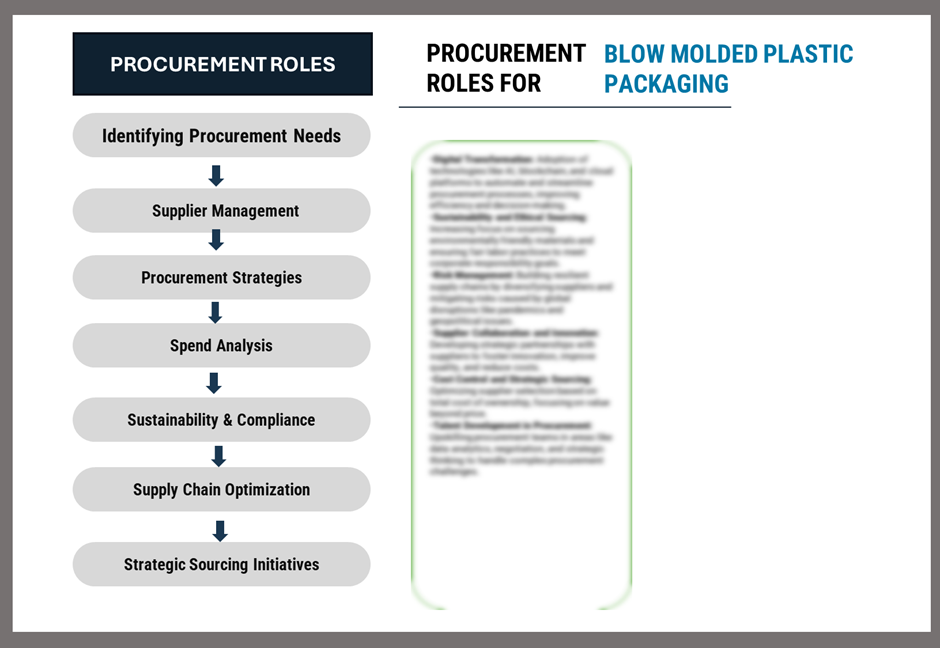
Pricing Outlook for Blow Molded Plastic Packaging: Spend Analysis
The pricing outlook for blow-molded plastic packaging is anticipated to remain stable, although moderate price increases may occur due to several influencing factors. The adoption of advanced manufacturing technologies, regulatory compliance requirements, and the rising need for high-quality packaging solutions for diverse industries are key contributors to potential price hikes. As demand for packaging solutions grows across sectors like food and beverage, pharmaceuticals, and consumer goods, these elevated costs could result in higher packaging prices.
To maintain competitive pricing in the long term, businesses are focusing on operational efficiency, optimizing production processes, and incorporating automation tools. Collaborating with suppliers of sustainable materials or technological partners can also provide cost-effective solutions. Despite these cost increases, a focus on innovation, quality assurance, and regulatory compliance will be essential for controlling pricing. As the demand for blow-molded plastic packaging increases, balancing cost efficiency with high-quality standards will remain crucial for stakeholders in this industry.
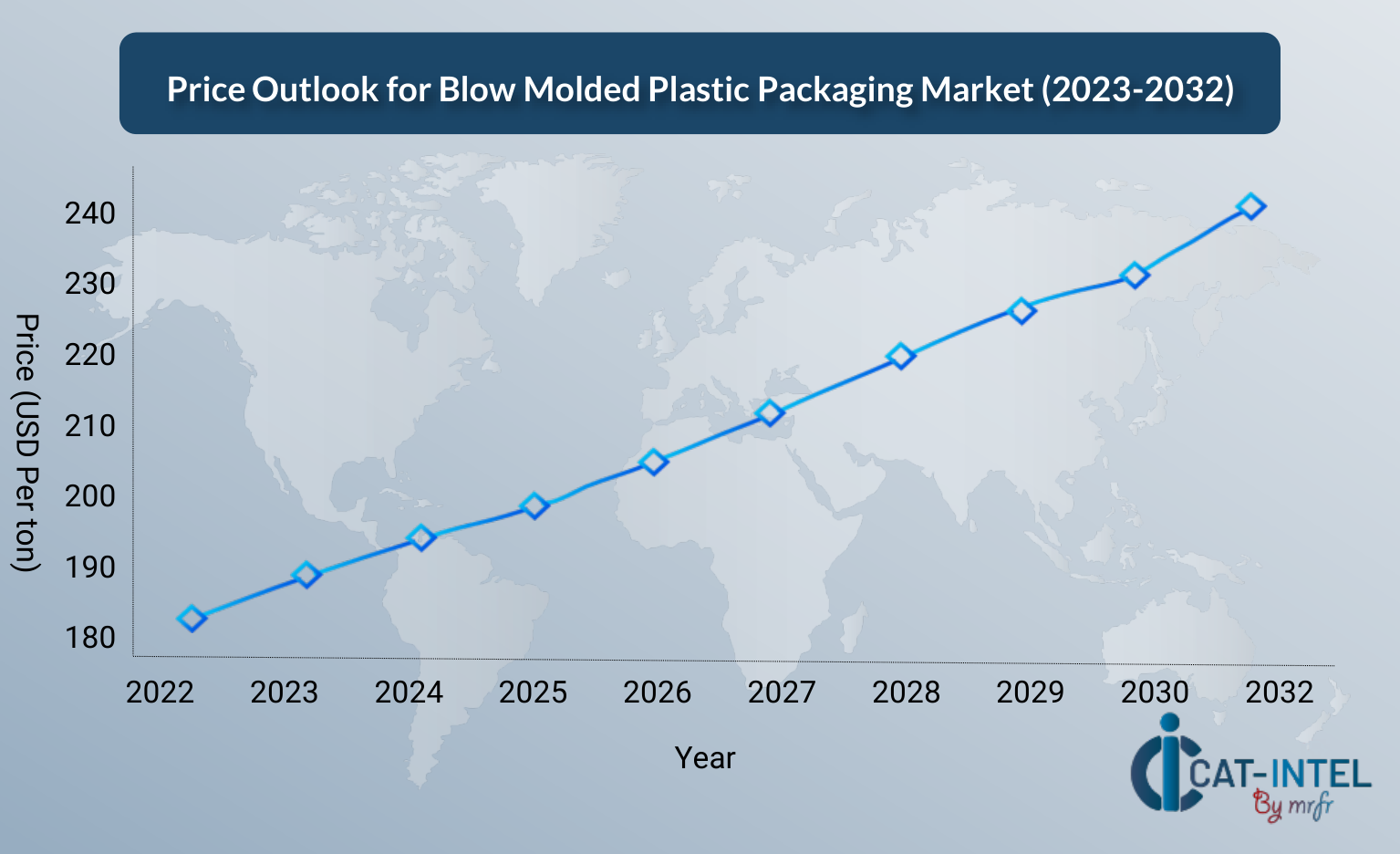
Graph shows general upward trend pricing for blow molded plastic packaging and growing demand. However, there may be fluctuations influenced by economic conditions, technological advancements, and competitive dynamic.
Efforts to improve operational efficiency, optimize production processes, and implement automation technologies can help businesses maintain competitive pricing over time in the blow-molded plastic packaging industry. Collaborating with technology partners, research institutions, or eco-friendly suppliers can also provide cost-effective solutions.
Although costs may increase, maintaining a focus on innovation, quality, and regulatory compliance will be essential to manage pricing effectively. As the demand for blow-molded plastic packaging grows across various industries, striking a balance between cost efficiency and high-quality service will be critical for stakeholders in this sector.
Cost Breakdown for Blow Molded Plastic Packaging: Total Cost of Ownership (TCO) and Cost-Saving Opportunities
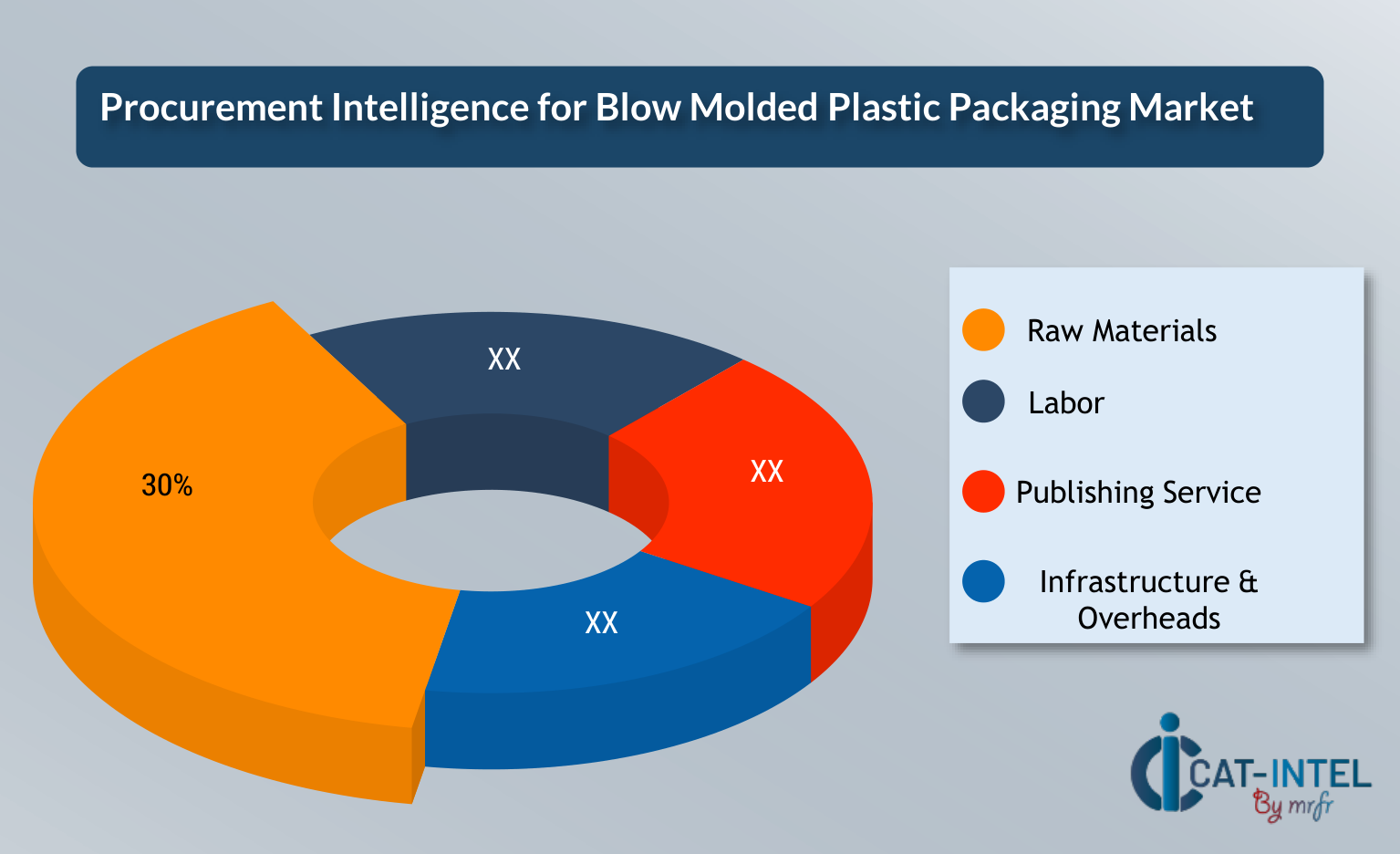
- Raw Materials (30%)
- Description: The primary raw materials used in blow-molded plastic packaging include various types of plastic resins such as polyethylene, polypropylene, and PET, which are essential for producing durable and safe packaging. These materials must meet stringent quality standards to ensure the safety, effectiveness, and regulatory compliance of the packaging.
- Trends: There is a growing demand for sustainable raw materials in the market, driven by environmental concerns and tightening regulations. The shift toward recycled plastics and biodegradable materials is gaining momentum. Additionally, improvements in raw material sourcing, including better logistics and more efficient usage, are reducing costs and waste.
- Labor (XX%)
- Publishing Services (XX%)
- Infrastructure & Overheads (XX%)
Refining procurement and operational strategies, blow-molded plastic packaging
Cost-Saving Opportunities: Negotiation Leverage and Purchasing Strategies

companies can realize substantial cost efficiencies. Collaborating with raw material suppliers, manufacturers, and logistics providers allows companies to negotiate volume discounts, secure better pricing, and share resources, reducing overall costs.
Investing in modern production technologies, including automated blow molding systems, and enhancing data management can streamline operations, reduce labor requirements, and improve output quality. Additionally, adopting sustainable practices, such as reducing plastic waste and using recycled materials, can help reduce costs and improve the company's environmental footprint, aligning with growing consumer and regulatory demands for sustainability.
Supply and Demand Overview for Blow Molded Plastic Packaging: Demand-Supply Dynamics and Buyer Intelligence for Effective Supplier Relationship Management (SRM)
The blow-molded plastic packaging market is experiencing steady growth, driven by increasing demand across multiple sectors, including food and beverage, pharmaceuticals, and consumer goods. This growth is further supported by advancements in packaging technology, rising consumer preferences for sustainable packaging, and an expanding global market.
Demand Factors:
-
Increasing Demand for Sustainable Packaging Solutions: As environmental concerns rise, there is an increasing need for eco-friendly and recyclable blow-molded plastic packaging. This drives demand for packaging solutions that meet sustainability standards. -
Growth in End-Use Industries: Industries such as food and beverage, pharmaceuticals, and personal care are expanding, which fuels demand for blow-molded plastic packaging to meet packaging needs for a variety of products. -
Rising Consumer Preference for Convenience: The demand for convenience-oriented packaging, such as single-use containers and easy-to-carry bottles, is boosting the need for blow-molded plastic packaging solutions. -
Technological Advancements in Packaging Designs: As packaging technology evolves, demand grows for innovative, more efficient, and custom-designed blow-molded plastic packaging solutions that provide better durability, functionality, and aesthetics.
Supply Factors:
-
Advancements in Manufacturing Technology: The development of state-of-the-art blow molding machines and automation tools is improving production efficiency and capacity, helping suppliers meet rising demand while maintaining quality. -
Access to Raw Materials: The supply of raw materials like polyethylene, polypropylene, and PET resins affects the availability of blow-molded plastic packaging. Fluctuations in material costs and supply chain disruptions can impact the ability to meet demand. -
Skilled Workforce and Production Capacity: The availability of skilled labor and the capacity of manufacturing facilities are essential in meeting growing demand. Shortages of skilled workers or limited production capacity can create challenges for timely delivery. -
Competitive Market Pressures: The increasing number of companies producing blow-molded plastic packaging has led to price competition. This drives improvements in production processes and quality but can also put pressure on pricing and resources.
Regional Demand-Supply Outlook: Blow Molded Plastic Packaging
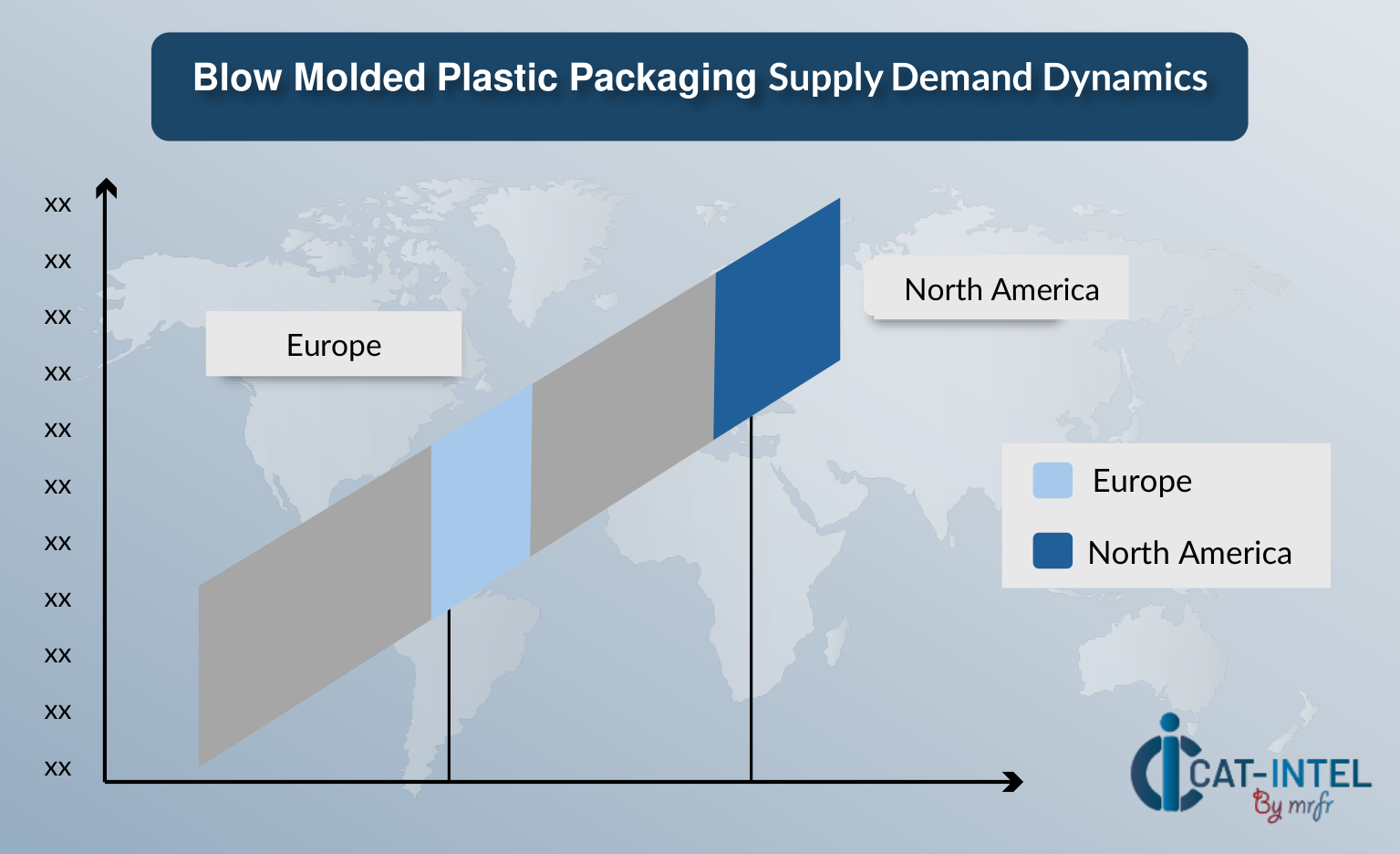
The Image shows growing demand for blow molded plastic packaging in both North America and Europe, with potential price increases and increased Competition.
North America: Leading Market for Blow Molded Plastic Packaging
North America, particularly the U.S. and Canada, holds a dominant position in the blow-molded plastic packaging market, driven by several key factors:
-
Increasing Demand for Sustainable Packaging: As consumer preference for environmentally friendly packaging grows, North American companies are increasingly adopting recyclable and biodegradable blow-molded plastic packaging to meet regulatory standards and consumer expectations. -
Advanced Manufacturing Infrastructure: The region benefits from a robust manufacturing ecosystem, with access to advanced blow molding technologies, state-of-the-art laboratories, and highly efficient production lines, all contributing to the accuracy and reliability of packaging solutions. -
Stringent Regulatory Requirements: North America enforces strict regulations for packaging materials, particularly for industries such as food, pharmaceuticals, and personal care. Compliance with these standards ensures that the packaging is safe, functional, and meets consumer expectations. -
Innovation in Packaging Solutions: The North American market is a hub for innovation, where new packaging technologies, such as smart packaging and sustainable materials, are continuously being developed. These innovations help meet the growing demand for functional and eco-friendly blow-molded plastic packaging solutions

North America Remains a key hub blow molded plastic packaging can price drivers Innovation and Growth.
Supplier Landscape: Supplier Negotiations and Strategies
The supplier landscape in the blow-molded plastic packaging market is diverse, with a range of global and regional players providing packaging solutions across various industries. These suppliers play a crucial role in shaping market trends, affecting pricing, innovation, and supply chain efficiency. The market is highly competitive, comprising large multinational packaging firms and specialized companies that focus on sustainable and high-quality packaging solutions.
Currently, the supplier landscape sees significant consolidation among major packaging manufacturers who hold a substantial share of the market. At the same time, smaller and emerging companies are carving out their niche by focusing on innovative materials, specialized packaging designs, and sustainable solutions.
Some key suppliers in the blow-molded plastic packaging market include:
- Amcor
- Berry Global
- Plastipak Packaging
- Sealed Air Corporation
- Alpha Group
- Sidel Group
- Sipa
- Krones AG
- Greiner Packaging
- SABIC
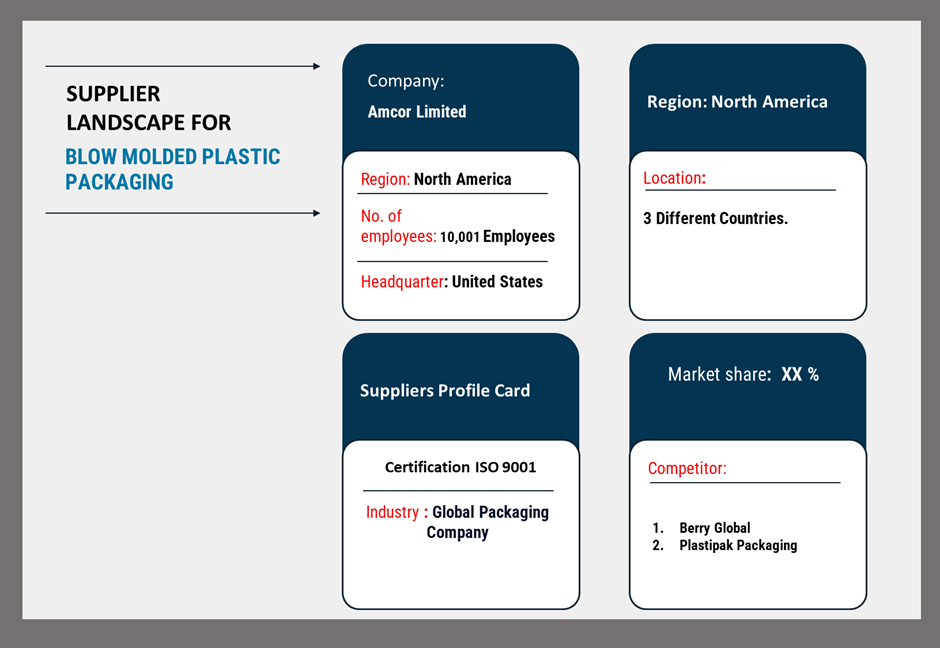
Key Developments Procurement Category Significant Development:
Blow Molded Plastic Packaging Attribute/Metric |
Details |
Market Sizing |
Global blow molded plastic packaging market is expected to reach USD 103.4 billion by 2032, growing at a CAGR of approximately 3.5% from 2024 to 2032. |
Blow Molded Plastic Packaging Technology Adoption Rate |
Around 45% of packaging manufacturers are adopting advanced technologies such as automation, 3D printing, and sustainable material. |
Top Blow Molded Plastic Packaging Strategies for 2024 |
Focus on sustainability, adoption of eco-friendly materials, enhancing production efficiency, and optimizing packaging designs to meet consumer and regulatory demands. |
Blow Molded Plastic Packaging Process Automation |
35% of companies in the packaging sector have implemented automation in production lines to reduce waste, improve consistency, and cut costs. |
Blow Molded Plastic Packaging Process Challenges |
Major challenges include rising raw material costs, sustainability concerns, regulatory pressures on recyclability, and supply chain disruptions. |
Key Suppliers |
Leading suppliers include Amcor, Berry Global, Plastipak Packaging, Alpha, and Greiner Packaging, offering a wide range of blow-molded plastic packaging solutions. |
Key Regions Covered |
North America, Europe, Asia-Pacific, with key markets in the U.S., China, India, and Germany due to strong demand from food and beverage, pharmaceuticals, and consumer goods industries. |
Market Drivers and Trends |
Growth is driven by the increasing demand for sustainable packaging, advancements in manufacturing technologies, and the expansion of the food and beverage and pharmaceutical industries. |

